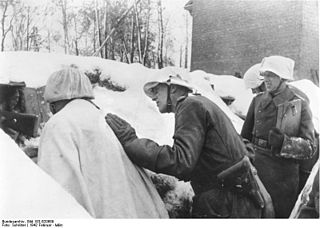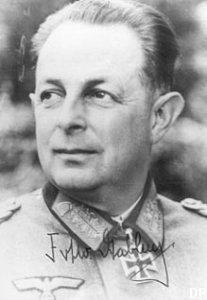
The 1st Panzer-Division was an armoured division in the German Army during World War II.
The 10th Infantry Division was created in October 1934 under the cover name Wehrgauleitung Regensburg to hide its violation of the Treaty of Versailles. It was renamed the 10th Infantry Division when the establishment of the Wehrmacht was announced publicly in October 1935.
The German 206th Infantry Division, was a military unit that served during World War II. Like most German infantry units it had no motorization, and relied on leg and horse mobility.
The 9th Mountain Division was the name given to two separate German military divisions by accident in 1945.
The Panzerkorps Großdeutschland was a German panzer corps in the Wehrmacht which saw action on the Eastern Front in 1944/1945 during World War II.

The Battle of the Kamenets–Podolsky pocket was part of the larger Soviet Proskurov–Chernovtsy offensive, whose main goal was to envelop the Wehrmacht's 1st Panzer Army of Army Group South. The envelopment occurred in late March 1944 on the Eastern Front during the Dnieper–Carpathian offensive. It was the biggest and most important operation of the Dnieper–Carpathian offensive.

In military history, the German term Kampfgruppe can refer to a combat formation of any kind, but most usually to that employed by the Wehrmacht of Nazi Germany and its allies during World War II and, to a lesser extent, the German Empire in World War I.

The 18th Army was a World War II field army in the German Wehrmacht.
A stay-behind operation is one where a country places secret operatives or organizations in its own territory, for use in case of a later enemy occupation. The stay-behind operatives would then form the basis of a resistance movement, and act as spies from behind enemy lines. Small-scale operations may cover discrete areas, but larger stay-behind operations envisage reacting to the conquest of whole countries.
This is the complete order of battle of Allied and German forces involved during Operation Market Garden.
The 719th Infantry Division was a German Army division of World War II.

The Baltic Landwehr or Baltische Landeswehr was the name of the unified armed forces of Couronian and Livonian nobility from 7 December 1918 to 3 July 1919.

The 30th Waffen Grenadier Division of the SS(1st Belarusian), originally called the 30th Waffen Grenadier Division of the SS , was a short-lived German Waffen-SS infantry division formed largely from Belarusian, Russian, Polish, and Ukrainian personnel of the Schutzmannschaft-Brigade Siegling in August 1944 at Warsaw in the General Government.
The 8th Ersatz Division was a unit of the German Army in World War I. The division was formed on mobilization of the German Army in August 1914. The division was a composite division, formed from 14 brigade replacement battalions (Brigade-Ersatz-Bataillone) from the Kingdom of Württemberg, the Grand Duchy of Hesse, the Rhine Province, the Province of Hesse-Nassau and the Imperial Territory of Alsace-Lorraine. It became more Württemberg as the war progressed; and, in February 1917, it was officially designated a Royal Württemberg division. It was redesignated the 243rd Infantry Division in April 1917.
The 4th Ersatz Division was a unit of the German Army, in World War I. The division was formed on mobilization of the German Army in August 1914. The division was disbanded in 1919, during the demobilization of the German Army after World War I.

The 10th Ersatz Division was a unit of the German Army in World War I. The division was formed on the mobilization of the German Army in August 1914. The division was disbanded in 1919 during the demobilization of the German Army after World War I.
The 19th Ersatz Division was a unit of the German Army, in World War I. The division was formed on the mobilization of the German Army in August 1914. The division was disbanded in 1919, during the demobilization of the German Army after World War I.

Eccard Freiherr von Gablenz was a German general in the Wehrmacht during World War II who commanded several divisions. He participated in the campaigns of Poland, France and the invasion of the Soviet Union. Gablenz stayed on the Russian Front from 1941 to 1943. He later assumed command of the 232nd Infantry Division in Italy, a command he held until the final surrender in May 1945.
The 444th Security Division was a rear-security division in the Wehrmacht of Nazi Germany. The unit was deployed in German-occupied areas of the Soviet Union, in the Army Group South Rear Area.
Transportkorps Speer was created in 1944 from Legion Speer and the units of the National Socialist Motor Corps that was serving the Organisation Todt. Shortly after its creation it became subordinated to the Wehrmacht. Yet, its major mission remained in support of OT, which at this time was mainly engaged in rebuilding and repair of bomb damaged industrial facilities and housing complexes. Transportkorps Speer was organized in motor transportation battalions and regiments, supported by depot, repair, engineering, signal, and medical units.







